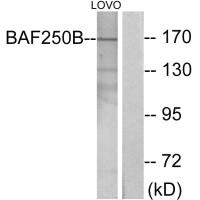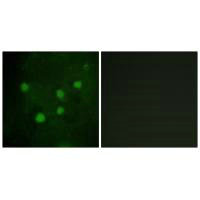
Western blot analysis of extracts from LOVO cells, using BAF250B antibody.
ARID1B Antibody
CSB-PA210417
ApplicationsImmunoFluorescence, Western Blot, ELISA
Product group Antibodies
ReactivityHuman, Rat
TargetARID1B
Overview
- SupplierCusabio
- Product NameARID1B Antibody
- Delivery Days Customer20
- ApplicationsImmunoFluorescence, Western Blot, ELISA
- CertificationResearch Use Only
- ClonalityPolyclonal
- ConjugateUnconjugated
- Gene ID57492
- Target nameARID1B
- Target descriptionAT-rich interaction domain 1B
- Target synonyms6A3-5; ARID domain-containing protein 1B; AT rich interactive domain 1B (SWI1-like); AT-rich interactive domain-containing protein 1B; BAF250B; BRG1-associated factor 250b; BRG1-binding protein ELD/OSA1; BRIGHT; CSS1; DAN15; ELD (eyelid)/OSA protein; ELD/OSA1; MRD12; OSA2; P250R; SMARCF2
- HostRabbit
- IsotypeIgG
- Protein IDQ8NFD5
- Protein NameAT-rich interactive domain-containing protein 1B
- Scientific DescriptionInvolved in transcriptional activation and repression of select genes by chromatin remodeling (alteration of DNA-nucleosome topology). Belongs to the neural progenitors-specific chromatin remodeling complex (npBAF complex) and the neuron-specific chromatin remodeling complex (nBAF complex). During neural development a switch from a stem/progenitor to a post-mitotic chromatin remodeling mechanism occurs as neurons exit the cell cycle and become committed to their adult state. The transition from proliferating neural stem/progenitor cells to post-mitotic neurons requires a switch in subunit composition of the npBAF and nBAF complexes. As neural progenitors exit mitosis and differentiate into neurons, npBAF complexes which contain ACTL6A/BAF53A and PHF10/BAF45A, are exchanged for homologous alternative ACTL6B/BAF53B and DPF1/BAF45B or DPF3/BAF45C subunits in neuron-specific complexes (nBAF). The npBAF complex is essential for the self-renewal/proliferative capacity of the multipotent neural stem cells. The nBAF complex along with CREST plays a role regulating the activity of genes essential for dendrite growth By similarity. Binds DNA non-specifically. Mungall A.J., Nature 425:805-811(2003). Mangel L., J. Biol. Chem. 273:30466-30471(1998). Imbert G., Nat. Genet. 14:285-291(1996).
- ReactivityHuman, Rat
- Storage Instruction-20°C or -80°C
- UNSPSC12352203

